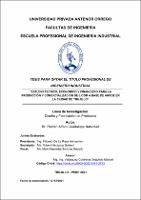Estudio técnico, económico y financiero para la producción y comercialización de licor base de arroz en la ciudad de Trujillo

View/
Download
(application/pdf: 2.407Mb)
(application/pdf: 2.407Mb)
Date
2022Author(s)
Roldán Alfaro, Guadalupe Natividad
Metadata
Show full item recordAbstract
El presente trabajo de investigación tuvo como principal objetivo demostrar la
viabilidad de la instalación de una planta de producción y comercialización de
licor a base de arroz y para ello el estudio se inició mediante un análisis
estratégico del sector donde se desarrollara el proyecto a fin de determinar las
oportunidades y amenazas del macroentorno así como las fortalezas,
debilidades y el análisis de la competitividad directa e indirecta del
microentorno para finalmente determinar las estrategias a considerar en el
desarrollo del proyecto (Matriz FODA). Posteriormente se desarrolló el estudio
de mercado utilizando una encuesta para determinar la demanda objetivo del
producto y que este comprendido en el NSE “B” y “C”. Luego se realizó el
análisis de la localización de planta utilizando el método de factores
ponderados utilizando 16 factores claves dentro de los cuales se consideró la
inseguridad ciudadana y el factor apalancamiento como factores más
relevantes; como resultado se determinó el distrito de Trujillo como la localidad
más importante. Asimismo, se determinó la capacidad de planta optima en
base al análisis de costos y gastos operativos y financieros evaluándose por el
indicador VAN cuyo valor optimo fue de S/170,930.99 para una capacidad
optima de 34,739 unidades. Finalmente se realizó un análisis de costos y
gastos operativos, inversiones que demandara la implementación de la planta
para luego determinar la mejor alternativa de financiamiento y con ello elaborar
los estados financieros proyectados del balance y estados de resultados. Los
resultados fueron positivos desde el punto de vista económico y financiero con
un VANE y VANF de S/175,976.96 y S/126,939.60 respectivamente. Además,
se determinó una tasa interna de retorno económica de 40.79% y TIR
financiera de 60.12% superior a los costos financieros del portafolio de
inversiones ( WACC=12.48%) y tasa mínima de rentabilidad exigida por los
inversionistas (TMAR= 13.20%) lo que demostraron la viabilidad económica y
financiera del proyecto. The main objective of this research work was to demonstrate the viability of the
installation of a plant for the production and marketing of rice-based liquor and
for this the study began through a strategic analysis of the sector where the
project was developed in order to determine the opportunities and threats of the
macro-environment as well as the strengths, weaknesses and the analysis of
the direct and indirect competitiveness of the microentournment to finally
determine the strategies to be considered in the development of the project
(SWOT Matrix). Subsequently, the market study was developed using a survey
to determine the target demand for the product and that it is included in the NSE
““B““ and ““C““. Then the analysis of the plant location was carried out using the
weighted factors method using 16 key factors within which citizen insecurity and
the leverage factor were considered as the most relevant factors; as a result,
the district of Trujillo was determined as the most important locality. Likewise,
the optimal plant capacity was determined based on the analysis of costs and
operating and financial expenses, evaluated by the VAN indicator whose
optimal value was S/170,930.99 for an optimal capacity of 34,739 units. Finally,
an analysis of operating costs and expenses was carried out, investments that
the implementation of the plant demanded to then determine the best financing
alternative and thus prepare the projected financial statements of the balance
sheet and income statements. The results were positive from the economic and
financial point of view with a VANE and VANF of S/175,976.96 and
S/126,939.60 respectively. In addition, an internal rate of economic return of
40.79% and financial IRR of 60.12% higher than the financial costs of the
investment portfolio (WACC=12.48%) and minimum rate of return required by
investors (TMAR= 13.20%) were determined, which demonstrated the
economic and financial viability of the project.
Collections
- Ingeniería Industrial [356]

